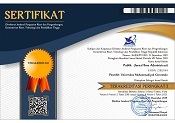Citizen Involvement: Fostering Alternatives and Risk Considerations on Natuna Rural Coastal Borderland
Abstract
Keywords
Full Text:
PDFReferences
Bourgon, J. (2007) ‘Responsive, responsible and respected government: Towards a New Public Administration theory’, International Review of Administrative Sciences, 73(1), pp. 7–26. doi: 10.1177/0020852307075686.
Cameron, K. (1980) ‘Critical Questions in Assessing Organizational Effectiveness’, Organizaional Dynamics, pp. 66–80.
Coulter, P. B. (2015) ‘Effec- Organizational tiveness in the Public Sector : The Example of Municipal Fire Protec- tion’, 24(1), pp. 65–81.
Creswell W. John.(2013). Research Design; Pendekatan Kualitatif, Kuantitatif, dan Mixed Method. Yogyakarta : Pustaka Pelajar.
Dehart-Davis, L. (2009) ‘Green tape: A theory of effective organizational rules’, Journal of Public Administration Research and Theory, 19(2), pp. 361–384. doi: 10.1093/jopart/mun004.
Goodsell, C. T. (2018) ‘Leisha DeHart- Davis, Creating Effective Rules in Public Sector Organizations’, 00(expected), pp. 1–3. doi: 10.1111/puar.12944.
Herman, R. (1990) ‘Methodological Issues an Studying the Effectivness of Nongovernmental and Nonprofit Organizations’, Nonprofit and Voluntary Sector Quarterly, (19), pp. 293–306.
Herman, R. D. and Renz, D. O. (1999) ‘Nonprofit and Voluntary Sector Quarterly Theses on Nonprofit Organizational Effectiveness’, 28(2), pp. 107–126. doi: 10.1177/0899764099282001.
Herman, R. D. and Renz, D. O. (2004) ‘Doing Things Right: Effectiveness in Local Nonprofit Organizations, A Panel Study’, Public Administration Review, 64(6), pp. 694–704. doi: 10.1111/j.1540-6210.2004.00416.x.
Liket, K. C. and Maas, K. (2015) ‘Nonprofit Organizational Effectiveness: Analysis of Best Practices’, Nonprofit and Voluntary Sector Quarterly, 44(2), pp. 268–296. doi: 10.1177/0899764013510064.
Nobbie, P. D. and Brudney, J. L. (2003) ‘Testing the Implementation, Board Performance, and Organizational Effectiveness of the Policy Governance Model in Nonprofit Boards of Directors’, Nonprofit and Voluntary Sector Quarterly, 32(4), pp. 571–595. doi: 10.1177/0899764003257460.
Peraturan Pemerintah Republik Indonesia Nomor 43 Tahun 2014 (2014) Peraturan Pemerintah Republik Indonesia Nomor 43 Tahun 2014 Tentang Peraturan Pelaksanaan Undang-Undang Nomor 6 Tahun 2014 Tentang Desa.
Rainey, H. G. and Steinbauer, P. (1999) ‘Galloping Elephants : Developing Elements of a Theory of Effective Government Organizations’, 9, pp. 1–32.
Undang-undang Nomor 6 Tahun 2014 tentang Desa
Willems, J., Boenigk, S. and Jegers, M. (2014) ‘Seven Trade-offs in Measuring Nonprofit Performance and Effectiveness’, Voluntas, 25(6), pp. 1648–1670. doi: 10.1007/s11266-014-9446-1.
Wolf, P. J. (1993) ‘A Case Survey of Bureaucratic Effectiveness in U . S . Cabinet Agencies : Preliminary Results 1’, pp. 161–181.
Article metrics
Refbacks
- There are currently no refbacks.
Copyright (c) 2019 Armauliza Septiawan

This work is licensed under a Creative Commons Attribution-ShareAlike 4.0 International License.

Publik (Jurnal Ilmu Administrasi) is licensed under a Creative Commons Attribution-ShareAlike 4.0 International License.










